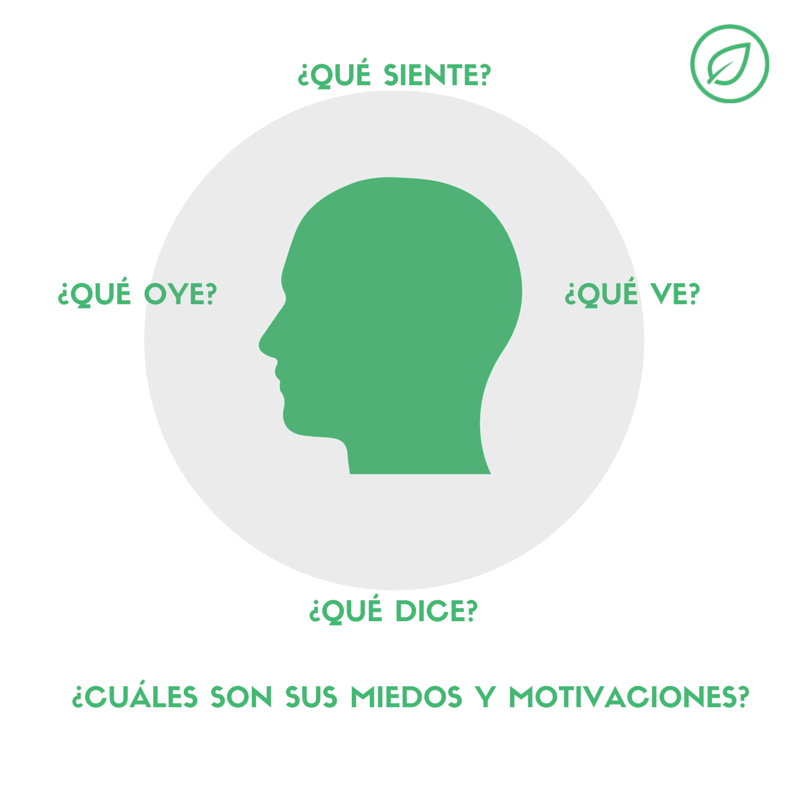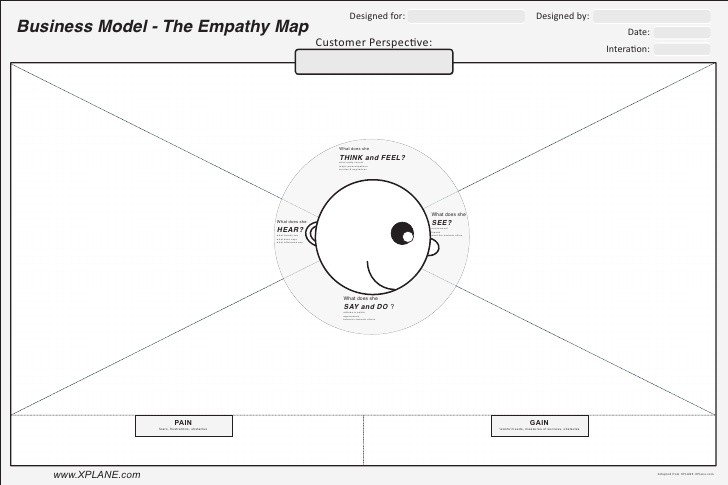Cómo crear un Mapa de Empatía para conocer a tu cliente
Una empresa ideal debería ser aquella que pudiese entender perfectamente lo que sus clientes quieren exactamente de sus productos y servicios. De esta forma, sería capaz de ofrecerles el mejor producto o servicio posible, adecuándolo a sus necesidades. Desafortunadamente, esto no es tan fácil de conseguir, ya que los consumidores son cada vez más exigentes y especializados. ¿Cómo podemos mejorar nuestra propuesta de valor?
En anteriores artículos os he hablado de la necesidad de definir variables como el Buyer Persona o el Buyer Journey en una estrategia de Inbound Marketing, pero hoy os voy a hablar de una herramienta que nos ayuda verdaderamente a ponernos en la piel de nuestro cliente: El Mapa de Empatía.
¿Qué es el Mapa de Empatía?
Es una herramienta de Design Thinking desarrollada por XPLANE, y que posteriormente tuvo mayor popularidad al aparecer en el famoso libro «Business Model Generation«, (2010) de Alex Osterwalder. Se trata de un elemento aplicable a cualquier tipo de negocio y que gira en torno al concepto de empatía (ponerse en la piel del otro).
Por ello, el empathy map tiene el objetivo de ayudarnos a comprender mejor a nuestro cliente a través de un conocimiento profundo de su entorno, su visión del mundo, deseos y necesidades. Normalmente las empresas hablan de clientes con características abstractas basadas en hipótesis y suposiciones. Este mapa nos ayuda a ir más allá de lo que el cliente dice y aparenta.
¿Para qué sirve un mapa de empatía?
En una estrategia de Inbound Marketing es importante conocer a nuestros clientes y no centrarnos en segmentos o suposiciones abstractas. Por ello, crear un mapa de empatía va a ser clave para identificar comportamientos, contextos y descubrir Insights inesperados. Recopilar toda esta información nos ayudará a comunicarnos y relacionarnos mejor con nuestros clientes, lo que hará que nuestra propuesta de valor sea más efectiva y tenga un enfoque más personalizado.
Al transformar segmentos de clientes en personas, podremos dar respuesta a cuestiones como estas sobre ellos:
- ¿Quiénes son de verdad?
- ¿A qué dedican su tiempo?
- ¿Quiénes son sus amigos?
- ¿Qué propuesta de valor esperan?
- ¿Cuánto están dispuestos a pagar por ella?
- ¿Qué les influencia?
- ¿Qué necesitan?
¿Cómo crear el Mapa de Empatía?
El ejercicio puede ser tan simple o complejo como tu quieras hacerlo, pero aquí tienes los pasos que Digital Menta considera que deberías seguir para crearlo:
1. Segmentar:
El primer paso será tener claro quienes son tus clientes, es decir, tus Buyer Persona, y posteriormente deberás agruparlos por atributos comunes (demográficos, estilo de vida, psicológicos, etc) hasta conseguir X segmentos. Nosotros recomendamos no crear más de 3, puesto que la estrategia se diversificaría demasiado.
2. Humanizar:
Una vez ya tienes los segmentos creados, tendrás que «dar vida» a una persona de cada segmento. Para ello, crearas un prototipo de perfil con nombre propio, una fotografía y su información. Darle personalidad concreta a lo que antes era un segmento de población te será útil para crearte una imagen mental y focalizar a quién tienes que dirigirte.
3. Empatizar:
Se trata de la etapa clave en la que realmente construimos el mapa de empatía contestando a preguntas en torno a 4 conceptos: FEEL, SEE, HEAR, SAY.

Los 6 cuadrantes a definir en el Mapa de Empatía
¿Qué piensa y siente? (define qué sucede en la mente del usuario):
- ¿Qué es lo que más le importa? (aunque no lo diga verbalmente).
- ¿Qué es lo que lo motiva?
- ¿Qué le quita las ganas de dormir?
- ¿Cuáles son sus sueños y aspiraciones?
¿Qué ve? (describe qué ve el usuario a su alrededor):
- ¿Cuál es su entorno?
- ¿Quiénes son sus verdaderos amigos?
- ¿Con qué tipo de ofertas es impactado diariamente?
- ¿Cuáles son las personas clave de alrededor?
- ¿Con qué tipo de problemas tiene que lidiar?
¿Qué oye? (explica cómo influye su entorno al usuario):
- ¿Qué es lo que oye en su entorno de trabajo?
- ¿Qué le dicen sus amigos y familia?
- ¿Qué personas tienen influencia en él?
- ¿Cómo lo hacen? ¿A través de que medios (comunicación, multimedia etc)?
¿Qué dice y hace? (piensa qué diría o cómo se comportaría el usuario en público):
- ¿Cómo se comporta habitualmente en público?
- ¿Qué actitud tiene?
- ¿Qué dice que le importa?
- ¿Con quién suele hablar?
- ¿Tiene influencia en alguien?
- ¿Hay diferencias entre lo que dice y lo que piensa?
A esto se le añaden 2 cuadrantes extra: Pains and Gains:
¿Cuáles son sus miedos y frustraciones?:
- ¿Cuáles es su mayor frustración?.
- ¿Qué miedos o riesgos le preocupan?
- ¿Qué obstáculos se interponen entre él y sus deseos o necesidades?.
- ¿Qué riesgos tiene miedo de asumir?
¿Cuáles son sus motivaciones?:
- ¿Qué desea o necesita conseguir en realidad?.
- ¿Qué significa el éxito para él?
- ¿Cómo lo pretende alcanzar?
4. Validar:
El mapa no es un elemento estático, sino que debe ser validado y revalidado las veces que sea necesario. Tendrás que testear y analizar constantemente las hipótesis que has construido para comprobar si son ciertas o no, e incluir nuevos descubrimientos o eliminar errores.
Puesta en práctica de nuestro mapa de empatía en sólo 3 pasos:
- En una pizarra o mural empieza dibujando en el centro a tu Buyer Persona o incluyendo su fotografía y escribe su información identificativa (edad, trabajo, educación, etc).
- Crea un cuadrado y divídelo en cuatro cuadrantes (FEEL, SEE, HEAR, SAY) y crea debajo otros dos para Pains and Gains.
- Rellena cada espacio con post it o notas con la información del usuario que has ido extrayendo.

Plantilla Mapa de la Empatía – XPLANE



